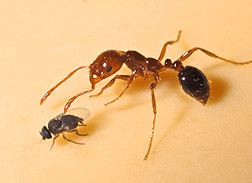New Red Imported Fire Ant Enemies in Place for Fight
Red imported fire ants first arrived in the United States in the early 1930s and have been expanding along the southern portion of the country ever since. These ants inhabit more than 350 million acres in 12 southern states and Puerto Rico, and they have recently become established in isolated sites in California and New Mexico. For more than a decade, ARS scientists have gone on the offensive against red imported fire ants by using natural enemies against them.
Entomologist Sanford Porter has worked to collect, breed, and release phorid flies that are now used to control fire ant populations in the southern regions of the United States. Porter is at the Center for Medical, Agricultural, and Veterinary Entomology’s (CMAVE) Imported Fire Ant and Household Insects Research Unit, in Gainesville, Florida.
The fire ants’ large numbers and potent sting have resulted in medical, agricultural, and environmental economic impacts that cost the U.S. public billions of dollars each year. Scientists at CMAVE and cooperators in several states conducted a program to suppress fire ants in large areas. The areawide project involved cooperators in five states and was successful in establishing self-sustaining and spreading populations of phorid flies from South America.
The fire ant biocontrol program, which began in 1995, has released five species of phorid flies to parasitize the various sizes of fire ants—from the large to the very small. “The relationship between phorid fly and fire ant is very specific: The introduced phorid fly species only attack imported fire ant species,” says Porter.
After several years of testing, Pseudacteon cultellatus was recently approved for field release. This new species of phorid fly is currently being released at several sites in Florida to control tiny fire ant workers that belong to multiple-queen colonies. “These colonies are particularly problematic, because they usually house two to three times the number of worker ants,” says Porter. “Target release sites typically have a large number of fire ants, diverse plant life, and water nearby.
“Of the four phorid fly species previously released, only one has failed to establish itself and widely spread out. P. litoralis, released in 2004 and 2005, was able to establish only in Alabama,” says Porter. “The others—P. tricuspis, P. curvatus, and P. obtusus—have expanded well beyond their release sites and are attacking fire ants in large regions. P. tricuspis and P. curvatus each cover about half of the U.S. fire ant range and are expected to increase to well over two-thirds of the range by the end of 2011.”—By Sharon Durham, Agricultural Research Service Information Staff.
This research is part of Veterinary, Medical, and Urban Entomology, an ARS national program (#104) described at www.nps.ars.usda.gov.
Sanford Porter is in the USDA-ARS Imported Fire Ant and Household Insects Research Unit, Center for Medical, Agricultural, and Veterinary Entomology, 1600-1700 S.W. 23rd Dr., Gainesville, FL 32608; (352) 374-5914.
"New Red Imported Fire Ant Enemies in Place for Fight" was published in the January 2011 issue of Agricultural Research magazine.








